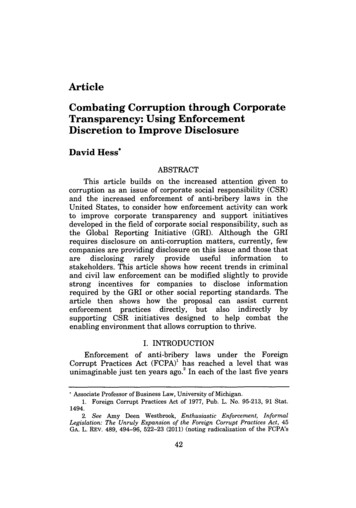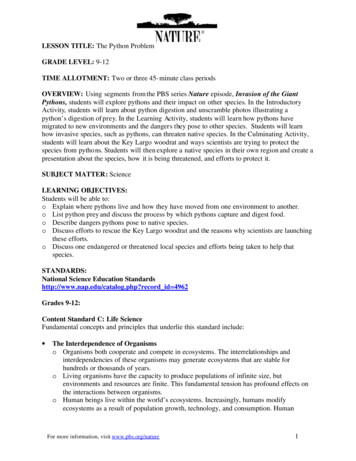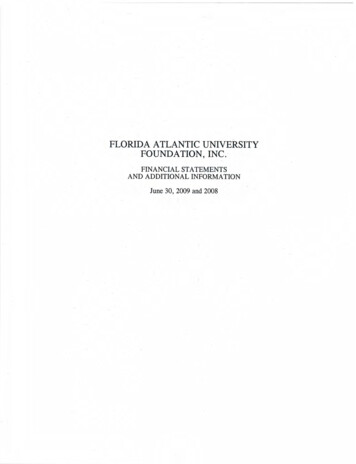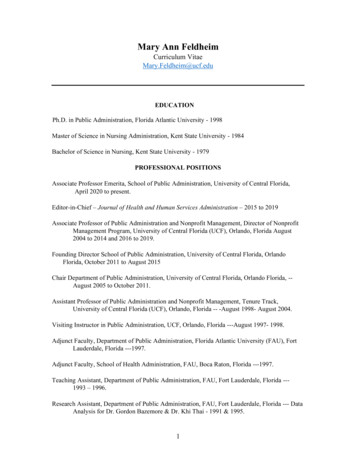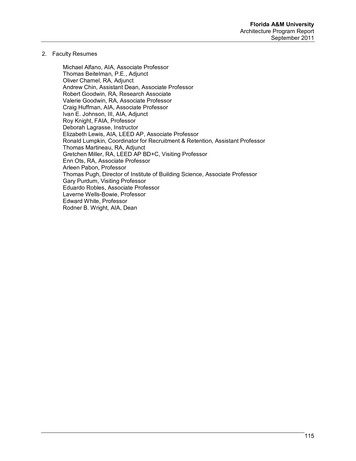
Transcription
Combating Burmese Pythons in FloridaJuly 2019Florida Fish and Wildlife Conservation CommissionThis document summarizes a the status of python control in Florida.Division: Habitat and Species ConservationAuthors: Sarah Funck, Kristen Sommers, and Melissa Miller, Ph.D.Report date: July 2019All Photos are MyFWC unless otherwise noted.1
Nonnative Wildlife in FloridaImage courtesy of Department of Environmental ProtectionFlorida’s subtropical climate is conducive to the establishment and expansion of manynonnative species including pythons, large lizards such as tegus, monitors and iguanas,many freshwater fish species and even mammals. Over 500 different species have beendocumented in Florida. Of these introductions, 125 species are estimated to havereproducing populations.The FWC’s Nonnative Fish and Wildlife Program is charged with determining whichnonnative fish and wildlife species may become established and cause a problem forFlorida’s ecology, economy or human health and safety. Those species causing adverseimpacts or are likely to cause adverse impacts are considered invasive.The majority of Florida’s invasive species became established after they either escaped orwere illegally released from captivity.Photos:Left: Nile monitor in southeast Florida (FWC)Center: Yellow anaconda was removed from Myakka River state park in Sarasota County,Florida on March 29, 2018 (FDEP)Right: Mongoose removed from south Florida (FWC)2
Invasive Pythons Large constrictor Not native to Florida Can lay up to 100 eggs per clutch Generalist diet Extremely difficult to find Excellent dispersers on land and in water No population estimates in FloridaBurmese pythons may be one of the most well‐known invasive species in Florida. This largeconstrictor snake, native to southeast Asia, can grow to be over 20 feet in length.Possessing many traits common to successful invasive species, pythons have highreproductive output, a generalist diet and can tolerate a variety of habitats. As adults, theylack natural predators in Florida. Their diet in Florida consists of mammals, birds, andreptiles including alligators. Pythons have also been documented to consume white‐taildeer.Pythons are well established in south Florida, utilizing vast natural areas. This crypticspecies is hard to detect even in grass as short as 3‐6 inches high. Though estimatingpopulation size has not been possible due to low detectability, to date, over 8,000 pythonshave been observed or removed from Florida and reported to the FWC since 1979. Thecombination of low detection rates and harsh and difficult to access habitat has challengedthe FWC and other public land manager’s ability to remove or control the presence orspread of this species.In their native range, python numbers have dwindled. This population decline is likely dueto extreme habitat loss and increasing human population. Pressure from animal trade hasalso contributed to their decline in Asia.3
How Pythons Got Here 1960’s-early 2000’s: Booming python pet trade Unwanted pets released Likely multiple introductions 1979: First python documented in Florida’senvironment in Everglades National Park 1992: Hurricane Andrew destroyed breedingfacility Spread across south Florida’s natural areasA misconception exists regarding how pythons became established in Florida. Some believeHurricane Andrew in 1992 caused the python problem, but pythons had been detectedprior to that hurricane event. Since the mid 1900s, Burmese pythons were a popular pet inthe live animal trade due to their beautiful markings and low cost coming out of southeastAsia. Importation data from 1989‐2000 indicates that Burmese pythons were the fourthmost popular snake brought into the U.S. From 1999‐2006, federal importation data showover 99,000 individual Burmese pythons were imported to the U.S. Breeders and vendorssold python hatchlings to buyers. Within a few years 12 inch hatchlings can grow tounmanageable sizes for many people. Captive pets can grow 8 inches/month; among thefastest recorded for all snakes and females can reach maturity in 3 years. We will neverknow the exact cause of the invasion, but several introduction events likely occurred inmultiple locations across south Florida. The first documented Burmese python in the wildoccurred in1979 along Tamiami Trail on the northeast end of Everglades National Park.Cryptic species, like pythons, can go undetected and impacts can be unrecognizable untilthe point of eradication is not possible. In 1992, a category 5 hurricane (Andrew) added tothe python problem by destroying a breeding facility near Homestead that resulted in therelease of additional pythons.Photo: Python nest removed by a FWC paid hunter – some of the 39 eggs.4
1979 - First Burmese pythonremoved from EvergladesNational ParkThe first documented Burmese python was found in Florida in 1979 near the northeastportion of Everglades National Park. The star on this map indicates the location of thatpython.5
2019 - Burmese pythons havebeen removed from manyareas in Florida and areestablished in natural areas ofSouth FloridaPythons are now established at least as far south as Key Largo and possibly further in theKeys, north to Loxahatchee National Wildlife Refuge, where they have been documented inlow numbers on the east coast of Florida, areas south of Lake Okeechobee, and westthrough Collier County. The points on this map indicate confirmed python observations orremovals. Points north of the known breeding range are likely escaped or released captiveanimals.6
Impacts from Invasive Pythons Predator of native wildlife Mammals Birds Reptiles Introduced parasites anddiseaseImage courtesy of Conservancy of SWFL Pentastomes NidovirusPythons are considered an invasive species in Florida due to their adverse impacts onnative wildlife. Pythons are dietary generalists, consuming a diversity of prey species. Theyconsume mammals, birds and reptiles including large prey items, such as whitetail deer(pictured here in a python removed by the Conservancy of SWFL) andendangered/threatened species, such as the Key Largo Woodrat.Researchers continue to learn more about the ecological disease and parasite risk thatpythons pose to Florida. It is now known that pythons brought a parasitic Asian species ofpentastome (a crustacean) to Florida. This parasite lives in the lungs and can be passed tonative species of snakes. Recent research indicates that the parasitic pentastomes are nowspreading independently of pythons and have been found from Key Largo to VolusiaCounty. Other emerging disease risks including nidovirus, may impact native species ofsnakes, but the extent or impacts of this virus on Florida’s wildlife are not fully understood.Photos:Right: Python removed by Conservancy of SWFL.Left: The large bulge in the body of the python was a white‐tail deer that was subsequentlyregurgitated by the python.7
Burmese Python Diet Mammals 70% of diet 23 species of mammalsImage courtesy of National Park Service Birds and reptiles 30% of diet 43 species of birds 2 species of reptilesImage courtesy of University of FloridaMany python diet studies have been conducted in Florida. These studies indicate thatmammals may make up 70% of their diet, including 23 different species. The federallyendangered Key Largo Woodrat has been documented in at least one python.Pythons are also known to consume 43 species of birds and at least 2 species of reptiles,making up about 30% of their diet. Pythons have been found on tree islands in theEverglades targeting bird rookeries. Studies have documented python consumption of theRoseate Spoonbill (state‐threatened) and the American Wood Stork (federally threatened).Both of these species are considered indicator species of Everglades restoration.Photo:Top: Burmese python with large prey item in stomach (NPS).Bottom: Gut contents removed from a Burmese python: Roseate Spoonbill and Pied‐billedGrebe (UF).8
Overarching Python Management Goals Minimize adverse impacts to ecology of Florida Prevent new introductions and spread of established population Engage with partners and stakeholders in management processDue to their cryptic nature, pythons are incredibly hard to find; thus, we do not have apopulation estimate for them in Florida and extirpation is unlikely with current technologyand available tools. Land managers can mitigate impacts and increase ecosystem function ifpythons are removed as much as possible. The FWC’s management goals includeminimizing adverse impacts to Florida ecology, preventing spread and establishment ofnew populations, and engaging with partners and stakeholders in the managementprocess.Photos:Left: FWC staff during a safe capture demonstration (FWC).Center: Python outreach flier.Right: FWC public meeting (FWC).9
Python Milestones TimelineFirst pythondocumented1960-70’sBoomingpythonpet trade1979FWCRegulationHurricane Andrew1980’sSpread acrossnatural areas insouth Florida1992EO 17-11; Payexperiencedpythonhunters2000’sFirst pythonreported inSWFL20102016Increaseddedicatedfunding for FWCpython n meetingThe FWC has been engaged in this issue for a long time. In 2008, FWC started regulatinglarge nonnative constrictor snakes by putting in rule the Reptiles of Concern language. Thisregulatory action required pet owners to register pythons as pets with the FWC. In 2010,Burmese pythons along with 7 other reptile species were added to the Conditional listunder Rule 68‐5 F.A.C., that limited future possession to research, commercial or publicexhibition uses. During the next few years, the FWC ramped up efforts to remove pythonsthat included developing multiple approaches to public removal such as allowing removalon public lands through a permitting process, providing educational events such as thePython Challenge events, and training members of the public on what to do when theyencounter a python.In 2017, FWC removed regulatory barriers to public removal by issuing Executive Order 17‐11 that allows for year‐long take of nonnative reptiles, including pythons on 22 public landswithout a permit or hunting license. That same year, the FWC launched a program to payexperienced people to remove pythons from some public conservation lands. Morerecently, the FWC has taken lead on python control coordination.10
FWC’s Role:Statewide responsibility for fishand wildlife resources Awareness and Education Regulation and Enforcement Research Support Control and Management CoordinationThe FWC has Constitutional authority to manage Florida’s fish and wildlife resources. TheFWC has responsibility at a statewide level to ensure the long‐term well‐being of nativewildlife. The FWC implements that role through awareness and education, researchsupport, regulation and enforcement, control/management and coordination.Photos:Left: Burmese python (FWC).Right: FWC staff providing a safe capture demonstration at Everglades Holiday Park (FWC).11
Awareness and Education Python ChallengeTM Worldwide awareness Thousands of participants Public Identification andCapture Training Over 2,400 trained 167 classes Exotic Species Hotline Sportsman’s CommunityImage courtesy of Dave SteenThe FWC has emphasized the importance of public awareness and education on invasivespecies and Burmese pythons have been the “poster child” for those efforts. Engaging thepublic through a variety of programs and initiatives and encouraging people to participatein these programs is a primary goal of the FWC. In 2013 and 2016, the FWC hosted theground‐breaking Python ChallengeTM as a way to remove pythons from the wild, but also toeducate the masses on this important topic. These events were very popular, attractingvisitors from all over the country and received worldwide media attention. The FWC alsotrains people on how to identify, report, and safely capture Burmese pythons. Since 2015,our staff have provided 167 trainings to over 2,400 people. The FWC also encourages thepublic to report sightings of nonnative wildlife to the FWC through the Exotic SpeciesHotline (888‐IVEGOT1). The FWC continues to support opportunities for the sportsman’scommunity to engage in python removal. In cooperation with partners, staff will beparticipating in an upcoming youth hunt for pythons in south Florida.Photos:Left: Eric Sutton at the 2013 Python ChallengeTM awards ceremony (FWC).Right: Photos of the 2016 Python ChallengeTM (FWC and Dr. David Steen)12
Regulation and Enforcement Rule 68-5. F.A.C. Listed as “Conditional” in2010 Not allowed as pets Permit required for import,research, exhibition,commercial sales Executive Order 17-11 Exotic Pet AmnestyAs the State agency with regulatory authority and enforcement capability, the FWC has alsotaken steps to regulate this invasive species. In 2010, the Burmese python was listed asConditional. This status requires a permit for possession for research, exhibition orcommercial sales. Personal possession of pythons is no longer allowed in Florida. The federalgovernment in 2012 added Burmese pythons to the Injurious Species List under the Lacey Actrequiring a permit from the U.S. Fish and Wildlife Service for importation into the U.S.Pythons are not protected and can be lethally taken year‐round. Pythons can be humanelykilled on private lands at any time with landowner permission and the FWC encouragespeople to remove and kill pythons from private lands whenever possible. Lethal take ofpythons on our Wildlife Management Areas through hunting activities had been authorized in2009 to help remove pythons by sportsmen. In 2017, the FWC removed barriers to lethal takeon Commission‐managed lands by issuing Executive Order 17‐11 allowing year‐round lethaltake of all nonnative reptiles including pythons without a permit or hunting license on 22Commission‐managed lands in south Florida. The FWC also offers a legal alternative to therelease of unwanted pets for people in possession of Burmese pythons through our ExoticPet Amnesty Program.Photos:Left: FWC Law Enforcement with captured python. (FWC)Right: Veterinarian examines a python surrendered at an Exotic Pet Amnesty Day event. (FWC)13
Research Support Diet studiesDetector dogsIrula tribePheromoneseDNATraps and luresImages courtesy of University of FloridaProviding support to researchers is another priority for the FWC. Management decisionsare science‐based and staff rely on university and other research partners to fill knowledgegaps on this species and explore innovative solutions to the python problem. Researchefforts have historically focused on diet and detection. Recent increases in State fundsprovided by the Florida Legislature have provided the FWC the opportunity to focus onrefining existing detection and removal tools and developing new innovative ways to findand remove pythons.Photos:Left Bottom: University of Florida staff conducting necropsy of Burmese python (UF).Center: University of Florida Irula tribe study (UF).Top: University of Florida eDNA study (UF).14
Research SupportFuture Opportunities Innovative detectiontechnology InfraredDronesSound wavesLuresImage courtesy of Pheromone manipulation Python specific trapWith continued advances in technology, the search for a solution to the python challenge isongoing. The FWC continues to support research and development of innovative detectionand removal tools.Photo: FWC, USDA and private industry testing an innovative python detection tool usingsound waves in water (FWC).15
Control and Management Contracted PythonRemoval Detector dogs Sentinel snakesImage courtesy of University of FloridaThe FWC relies on coordination and collaboration with partner agencies and organizationsto address the problem across geopolitical boundaries. Although research has been helpfulin developing and refining our ability to detect and remove pythons, a “silver bullet” doesnot exist to control pythons yet. Various tools and techniques exist to find and removepythons, and collectively partners use a multi‐faceted approach to management ofpythons.Photos:Top: PATRIC member with captured python (FWC).Center: PATRIC member with captured python (FWC).Bottom: University of Florida detection dog team (UF).Background: PATRIC member with captured python (FWC).16
Control and ManagementContracted Python Removal NPS Authorized Agents Everglades National Park Big Cypress National Preserve SFWMD Python EliminationProgram FWC’s Python Action Team –Removing Invasive Constrictors(PATRIC)Map to be updatedOne of the most effective tools for removing pythons is utilizing people experienced inpython removal. State and federal agencies utilize this technique through staff, volunteerprograms and paid experienced python hunters.Photo: Map indicating areas where members of the public can remove Burmese pythons.17
Control and ManagementImpact of Contracted Python RemovalSince the South Florida Water Management District and the FWC launched programs thatpay people experienced in python removal in 2017, python removals have increaseddramatically. National Park Service staff also noted an almost 160% increase in pythonremovals within Everglades National Park once paid python removal began inside the Parkby FWC.18
Control and ManagementPython Action Team – Removing Invasive Constrictors 42 expert teammembers Over 500 pythonsremoved Work on public lands Commission-managedlands Federal landsThe FWC compensates people experienced in python removal by contracting them toconduct surveys on public lands and to respond to reports of large nonnative constrictorsreceived across the State. This program began in April 2017, with 25 people, but it hasexpanded to include 42 people that can now work on state and federal properties includingseveral Wildlife Management Areas, Everglades National Park, Big Cypress NationalPreserve, and Biscayne National Park. To date, hunters have removed over 500 pythonsfrom the wild.Occasionally, the FWC will receive reports of large nonnative constrictors through theExotic Species Hotline (888‐IVEGOT1). If available, PATRIC team members are sent tocapture it and prevent new populations from establishing in new areas.Photos: FWC PATRIC members with captured pythons.19
Control and ManagementDetector Dogs Goal to detect pythons Previous detection dogresearch indicated thismethod as a potentialtool Dog teams Miccosukee tribe FWC coming soonImage courtesy of University of FloridaAnother promising tool includes using python detection dogs. These dogs are trained toalert to certain scents and they can be specific to species. Human search trials as comparedto detector dogs revealed that dogs can find pythons more quickly than humans in acontrolled situation, but they have limitations including a short work day, the need forspecific environmental conditions in which to work, and the limits of their handler.However, using dogs to help determine if a python is in the area will help human searcherstarget specific areas.An example of a successful targeted search occurred in 2016, when the FWC contractedwith University of Florida to use detector dogs to find pythons along the edge of theirknown range; specifically in Key Largo. The dogs alerted to the presence of pythons and afew days later, the Irula tribe located 4 pythons.Detection dogs have been used across the python’s range, but currently only theMiccosukee tribe uses detector dogs to find pythons. The FWC will be advertising a requestfor proposals to operationalize a detector dog team in the upcoming fiscal year.Photo: Detection Dog team from UF/Auburn University in 2016 study (UF).20
Control and ManagementSentinel Snakes Goal to remove reproductivefemales and learn behaviors Radio-tagged pythons Current locations Big Cypress NationalPreserve Rookery Bay NationalEstuarine ResearchPreserveImage courtesy of Conservancy of SWFLAnother tool proving successful in certain parts of south Florida is the use of Sentinelsnakes. Pythons are captured in the wild and appropriately sized individuals are fitted witha radio tag then rereleased at the point of capture. Through the use of telemetry, landmanagers are able to track the radio‐tagged python to learn about behaviors, habitat useand movement patterns, and most importantly to target breeding aggregations duringmating season. In the spring, pythons will form breeding balls of one female and multiplemale suitors. The radio‐tagged python, or Sentinel snake, can lead managers to not justone, but many reproductive adults leading to the removal of multiple individuals in areasthat might not otherwise be searched. This tool, though effective, can be very expensiveand labor intensive.Photo: Conservancy of SWFL staff using telemetry to locate a radio‐tagged python(Conservancy SWFL).21
Coordination Workshop for Ongoing Python Research Python Control and Management PublicWorkshops Interagency Python Control andManagement PlanEngage ementplansRe-engage forstakeholderfeedbackUltimately, this effort requires a statewide collaborative team composed of interagencypartners, and the FWC is leading the development of an interagency python control andmanagement plan. This plan will help land managers align their goals and identify actionitems to address pythons across Florida. Partners clearly work across boundaries tocooperate and have been doing so for years; however, the State does not yet have adocument that lays out the details and goals of python management. Agreed upon invasivespecies control and management plans have proven effective with collaborative partners(e.g. Melaleuca plan) and staff are striving to create this document for pythons now. Tokickstart this process, the FWC hired an Interagency Python Management Coordinator withthe support of Everglades National Park. The first meeting to develop this plan was held inFort Lauderdale in April 2019 and the next will be held in Naples in August. Over the courseof the next year, this interagency team will draft this plan and implement actions items inthe field.Photos:Left: FWC staff discussing pythons on an invasive species panel at the 2019 InternationalLeadership Conference for Women (FWC).Right: Interagency Python Control and Management Plan Workshop 2019 (FWC).22
Summary: Where do we go from here? Increase research on detection and removalmethodsAdd more experienced python huntersExpand areas of huntingImprove coordination among partnersIncrease public understanding, support andparticipation More pythons removedRange expansion reversedFewer pythons on landscapeFewer impacts to nativespeciesPhoto:Left: FWC Commissioner Kellam learning to capture pythons.Right: FWC Commissioner Rood with FWC PATRIC member who captured a python atEverglades Holiday Park in 2019 (FWC).23
The following slides are considered backup material andare not anticipated to be part of the actual presentation24
THE INVASION CURVEAREA INFESTED ContainmentEradicationPreventionCONTROL COSTS Asset Based Protection &Long‐term ManagementTIME Introduction25
FY 19-20 Research and Contractor ProjectsCategoryFundsPATRICDetector DogsPython TrapsMammal LuresIPMP FacilitationNidovirus testing 120,000 115,000 103,371 92,972 11,040 5,000TOTAL 447,38326
FWC Outreach Effort Python brochures English Spanish FWC Website ECISMAnewsletter Outreach events27
(picturedhere in a python removed by the Conservancyof SWFL) and endangered/threatened species, such as the Key Largo Woodrat. Researchers continue to learn more about the ecological disease and parasite risk that pythons pose to Florida. It is now known that pythons brought a parasitic Asian species of pentastome(a crustacean) to Florida.



